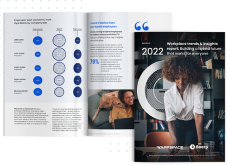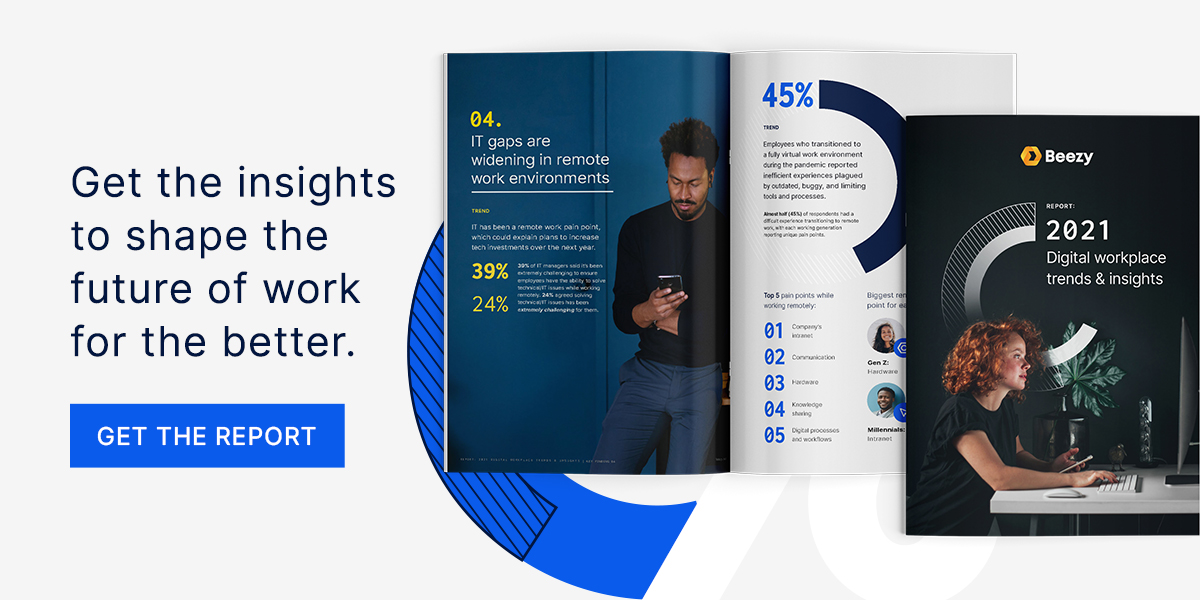
Too many tools are bad for productivity – here's what you can do
Maximo Castagno
June 23, 202141% of people who are currently working remotely claim the tools they’re using are actually getting in the way and leaving them feeling overwhelmed. A further 12% of people report feeling “extremely overwhelmed”.
The way we work is rapidly evolving. Even pre-pandemic, workforces around the world were moving towards increasingly flexible arrangements and remote working was on the rise. Most people would agree this is a positive shift, as it offers staff more independence and gives them greater control over their work-life balance. But with new opportunities come new challenges.
To better understand the issues facing organizations today, we surveyed 800 employees at large organizations to investigate the major pain points for workforces in 2021.
Unsurprisingly, improving productivity remains a top priority. Surprisingly, the tools people are using are failing them.
Get your copy of the Beezy report: 2021 Digital workplace trends & insights.
What's the issue?
In their quest to leverage the best and newest technologies, far too many organizations have opted for quantity over quality. But people don’t need more tools, they need better ones. In a recent Community Roundtable panel discussion, we talked about this very thing, in the context of community technology and where it’s headed.
Rather than investing in one streamlined platform, organizations rely on multiple technologies for their day-to-day operations – which leaves staff spending more time switching between tools than on actual work.
Not only does this disrupt workflow – as staff are having to log in and out of different accounts or jump between tabs – it creates unnecessary stress. With so many messages flying around, it’s easy for wires to get crossed.
So, what’s the solution?
Prioritize user experience
Often, the issue isn’t just the number of tools. It’s that they’re hard to use, or not suited to staff’s tasks and styles of working.
If an organization doesn’t prioritize personalizing the technology experience, employees will run into issues like having to constantly reload pages or scroll through unnecessary reminders to access information. Multiply these issues across several different apps and tools, and you’re left with an enormous, and enormously frustrating, time sink.
The remedy involves investing in a digital workplace solution that staff will actually want to use. With everything in one place, you can save time and be more able to focus on the task at hand – rather than worrying about what tool to use when and creating data silos.
This not only improves workflow and reduces stress but could save organizations thousands of dollars every year by making staff more efficient. Just imagine how much time, and therefore money, is currently spent jumping between tools in search of missing files and information.
Invest in streamlined design
It sounds simple, but making sure your digital workplace is as minimalist and visually non-disruptive as possible is also important. Having a screen clogged with dozens of open apps and tabs is like having a desk overloaded with papers: stressful!
A clean interface not only helps staff stay on top of their work by making sure they can easily see what’s going on, it adds to an overall feeling of calm.
Combat alert fatigue
More tools mean more notifications. The more notifications there are, the less likely staff are to respond to them. That might sound paradoxical, but alert fatigue is a very real thing. The human brain can only keep track of so many beeps and pings before we start to subconsciously tune them out. Essentially, if everything is ‘urgent’ nothing is.
Of course, the danger here is that when something truly urgent happens, staff won’t be paying attention, or the message will get lost in their inbox. This creates a fear of missing out, with staff constantly toggling between platforms to check they’re on top of everything. No wonder they end up feeling “overwhelmed”.
We designed Beezy to help bring order to comms chaos by giving managers the ability to share targeted messages with different audiences. Staff can also customize their newsfeeds, so they only see information that’s useful to them. As a result, people are far more likely to comment and collaborate. And naturally, when all messaging comes from one single source, it’s much easier to keep track of.
Highlight the importance of compliance
When an organization has many tools and no one single source of truth, there’s no real incentive for staff to stick to company-approved platforms. Staff are juggling multiple apps – and perhaps still struggling to get the job done – so it’s easy for them to feel that one more couldn’t hurt, even if it’s non-compliant.
Beezy enhances the whole of the Microsoft productivity suite, as well as working in harmony with third-party systems like Salesforce, which means everything staff need lives on one reliable destination.
Fewer tools equal less stress, and less chance of staff going rogue. According to our research, 65% of employees are currently using tools that aren’t explicitly company approved.
Happier staff are more productive
All of this isn’t just good for business – it drastically improves the employee experience. Clearly, when staff are forced to juggle too many tools and technologies, they end up feeling overworked, overwhelmed and even unable to act.
Responding to their concerns by streamlining operations isn’t just the right thing to do. It’s the best way to support them to do their finest work. Listen to your staff and reap the rewards.
Ultimately, the happier they are, the happier you will be.
Don't take our word for it
Beezy’s latest research report reveals 2021 digital workplace trends and insights, digging into the experiences of remote employees over the past year to uncover the biggest pain points, and the insights needed to make things better.



